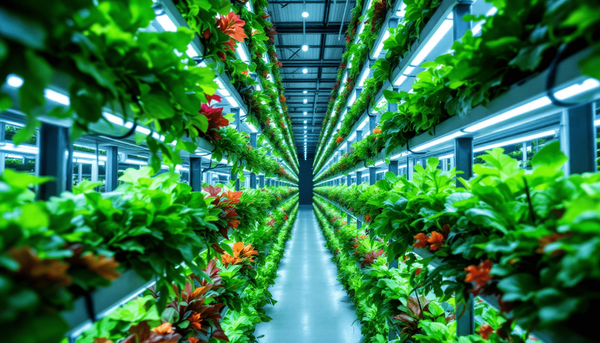Atmospheric Water Harvesting

The atmosphere above Earth's most arid deserts contains approximately 13,000 cubic kilometres of water vapour—six times the volume of all rivers combined—yet this vast reservoir remains tantalisingly inaccessible to conventional irrigation systems. Atmospheric water harvesting represents humanity's boldest attempt to tap this aerial ocean, employing revolutionary materials and thermodynamic processes to extract moisture from desert air where relative humidity barely exceeds 20 percent. This technology promises to transform barren landscapes into productive agricultural regions, potentially feeding billions whilst reversing desertification across continents.
The Physics of Aerial Moisture Capture
Understanding atmospheric water extraction requires grasping the fundamental relationship between temperature, pressure, and humidity at the molecular level. Water vapour exists in desert air even when relative humidity measures below 10 percent, with each cubic metre containing between 2 and 5 grammes of moisture. The challenge involves concentrating these dispersed molecules efficiently enough to produce liquid water at economically viable rates.
The breakthrough emerges from metal-organic frameworks, crystalline structures combining metallic nodes with organic ligands to create unprecedented internal surface areas exceeding 7,000 square metres per gramme. These materials, pioneered at British universities including Cambridge and Manchester, demonstrate extraordinary water-sorption capabilities, capturing moisture molecules through precisely engineered pore geometries measuring 0.5 to 2 nanometres—perfectly sized to accommodate water whilst excluding larger atmospheric constituents.
The harvesting cycle operates through temperature-swing adsorption, exploiting desert regions' extreme diurnal temperature variations. During cool night-time periods when relative humidity peaks, atmospheric water molecules diffuse into the MOF's nanopores, forming hydrogen bonds with functionalised surfaces specifically designed for water affinity. The material's hydrophilic sites—typically containing amine or hydroxyl groups—create localised regions of reduced vapour pressure, spontaneously drawing moisture from the surrounding air without requiring external energy input.
As solar radiation intensifies after dawn, the MOF temperature rises, weakening hydrogen bonds and releasing captured water as vapour into sealed collection chambers. This desorbed vapour, now concentrated far above atmospheric levels, condenses on cooled surfaces maintained below the dew point through passive radiative cooling or modest photovoltaic-powered refrigeration. The genius lies in utilising the desert's harsh temperature extremes—typically viewed as agricultural impediments—as the primary energy source driving the extraction process.
Recent advances at Imperial College demonstrate collection rates exceeding 3 litres per kilogramme of MOF material daily in environments with 20 percent relative humidity. The latest zirconium-based frameworks, designated MOF-303, maintain structural stability through thousands of hydration cycles whilst resisting degradation from ultraviolet radiation and temperature extremes ranging from -20 to 80 degrees Celsius.
Engineering Architecture of Industrial-Scale Harvesters
Scaling atmospheric water harvesting from laboratory demonstrations to agricultural irrigation demands sophisticated engineering addressing airflow dynamics, heat transfer optimisation, and material deployment across hectare-scale installations. Modern harvester designs incorporate vertical extraction towers reaching 30 metres, maximising exposure to moisture-laden air currents whilst minimising ground footprint on valuable agricultural land.
The towers employ forced convection systems drawing air through MOF-packed channels at velocities carefully calibrated to balance moisture capture against pressure drop penalties. Computational fluid dynamics modelling reveals optimal flow rates between 0.5 and 2 metres per second, providing sufficient residence time for water adsorption whilst processing atmospheric volumes exceeding 100,000 cubic metres hourly per tower.
Internal architecture features hierarchical porosity spanning multiple length scales. Macroscopic channels measuring 5-10 centimetres facilitate bulk airflow, whilst mesoscopic packed beds of MOF pellets provide high surface area contact. The pellets themselves—spherical or cylindrical granules measuring 2-5 millimetres—contain microscopic MOF crystals sintered together with polymer binders maintaining mechanical integrity whilst preserving accessible porosity.
Thermal management proves critical for maximising water yield. British engineers have developed phase-change material composites integrated within MOF beds, storing night-time cold and dampening temperature fluctuations during solar heating. These materials—typically paraffin waxes or salt hydrates encapsulated in graphene shells—maintain optimal adsorption temperatures during extended night-time collection periods whilst accelerating desorption through latent heat release during morning regeneration cycles.
The collection infrastructure employs biomimetic principles inspired by desert beetles and spider silk. Condensation surfaces feature hydrophilic-hydrophobic patterns creating preferential droplet formation sites and directional water transport. Microscopic grooves and hierarchical roughness, manufactured through laser ablation or chemical etching, reduce droplet adhesion and accelerate water collection into storage reservoirs.
Integration with existing irrigation systems requires careful consideration of water quality and distribution logistics. Atmospheric water emerges essentially distilled, lacking minerals present in groundwater. Remineralisation stations add essential nutrients including calcium, magnesium, and trace elements required for optimal plant growth. Smart irrigation controllers, guided by soil moisture sensors and weather forecasting algorithms, distribute harvested water precisely when and where crops require hydration, minimising evaporative losses.
Material Innovation and Sorption Chemistry
The evolution of atmospheric water harvesting materials represents a triumph of molecular engineering, progressing from simple silica gels to sophisticated designer frameworks optimised for specific humidity ranges and operating conditions. Understanding sorption chemistry at the atomic level enables rational design of materials surpassing natural moisture-capture mechanisms evolved over millions of years.
Contemporary MOFs employ diverse metal centres including zirconium, aluminium, iron, and titanium, selected for their coordination chemistry and stability under atmospheric conditions. The organic linkers—ranging from simple carboxylates to complex multi-topic aromatic systems—determine pore size, surface chemistry, and framework flexibility. British researchers at Oxford and Edinburgh lead development of machine learning algorithms predicting water uptake capacity from chemical structure, accelerating discovery of superior materials.
The water adsorption mechanism involves multiple stages beginning with isolated molecule capture at primary binding sites. As coverage increases, water clusters form through hydrogen bonding, eventually creating continuous networks within pores. This cooperative binding produces steep adsorption isotherms—dramatic uptake increases over narrow humidity ranges—enabling efficient moisture capture even from extremely dry air.
Surface functionalisation introduces specific chemical groups enhancing water affinity whilst maintaining rapid kinetics. Sulphonate groups create superhydrophilic regions initiating cluster formation at minimal humidity. Fluorinated sections provide hydrophobic channels accelerating vapour transport to active sites. This chemical patterning, inspired by protein water channels in biological membranes, optimises the balance between uptake capacity and regeneration ease.
Composite materials combining MOFs with hygroscopic salts demonstrate synergistic performance exceeding individual components. Calcium chloride or lithium bromide incorporated within MOF pores provides extreme water affinity, whilst the framework prevents deliquescence—salt dissolution in absorbed water—maintaining material integrity. These composites achieve water uptakes approaching 5 grammes per gramme of sorbent at 30 percent relative humidity, though regeneration requires higher temperatures than pure MOFs.
Alternative materials beyond MOFs show promise for specific applications. Hydrogels based on polyacrylamide or sodium polyacrylate swell dramatically upon water absorption, storing up to 500 times their dry weight. Whilst lacking MOFs' cycling stability, these materials prove valuable for single-use applications or seasonal water banking. Activated carbons derived from agricultural waste provide low-cost alternatives where performance requirements permit reduced efficiency.
Energy Systems and Thermodynamic Optimisation
Atmospheric water harvesting's energy requirements fundamentally determine economic viability and environmental sustainability. Thermodynamic analysis reveals minimum theoretical energy requirements of 2.5 megajoules per litre for extracting water from air at 20 percent relative humidity—equivalent to lifting water 250 metres against gravity. Practical systems currently consume 5-10 megajoules per litre, with ongoing research targeting sub-3 megajoule performance through process optimisation.
Solar energy integration appears mandatory for desert deployment where grid electricity remains unavailable or prohibitively expensive. Photovoltaic panels powering compression refrigeration can achieve condensation, but efficiency limitations and capital costs favour passive or hybrid approaches. Concentrated solar thermal systems provide high-temperature heat for sorbent regeneration, though tracking mechanisms and maintenance requirements pose challenges in dusty environments.
British innovations in radiative cooling offer elegant solutions for condensation without active refrigeration. Metamaterial surfaces engineered to emit infrared radiation at wavelengths matching atmospheric transparency windows—particularly 8-13 micrometres—achieve sub-ambient temperatures even under direct sunlight. These surfaces, incorporating alternating layers of silicon dioxide and hafnium dioxide with precisely controlled thicknesses, demonstrate cooling powers exceeding 100 watts per square metre at midday.
Thermodynamic cycles beyond simple temperature-swing adsorption promise improved efficiency. Pressure-swing systems compress moist air, reducing relative volume and forcing condensation, then expand the dried air to recover compression work. Multi-stage cascades employing different sorbents optimised for specific humidity ranges extract moisture more completely than single-stage systems. Hybrid cycles combining adsorption with membrane separation or thermoelectric cooling target theoretical efficiency limits.
Waste heat recovery from agricultural operations offers synergistic integration opportunities. Greenhouses in desert regions often require cooling, dissipating substantial thermal energy. Coupling greenhouse ventilation with water harvester regeneration cycles captures this otherwise wasted heat whilst providing dehumidification benefits. Similarly, photovoltaic panel cooling—necessary for maintaining efficiency in extreme desert heat—generates warm air streams suitable for MOF regeneration.
Energy storage enables continuous operation despite solar intermittency. Thermal batteries using molten salts or metallic phase change materials store daytime heat for night-time regeneration cycles. Compressed air storage in underground caverns provides mechanical energy for pressure-swing systems. These storage technologies, adapted from concentrated solar power installations, ensure reliable water production matching agricultural demand patterns.
Agricultural Revolution in Arid Regions
The agricultural implications of atmospheric water harvesting extend far beyond simple irrigation, fundamentally reimagining desert farming paradigms. Traditional desert agriculture relies on ancient aquifers or expensive desalination, both presenting sustainability challenges. Atmospheric water offers a perpetually renewable resource, limited only by energy availability and infrastructure investment.
Precision agriculture techniques synergise perfectly with atmospheric water harvesting's distributed nature. Rather than flood irrigation from centralised sources, networks of smaller harvesters positioned throughout fields provide localised moisture directly to root zones. This approach reduces water transport losses—typically 30-40 percent in conventional systems—whilst enabling crop-specific hydration optimisation.
Crop selection strategies must evolve to maximise atmospheric water utilisation. High-value vegetables and fruits justify harvesting infrastructure costs better than commodity grains. Hydroponic and aeroponic systems, where plants grow in nutrient solutions or misted air rather than soil, achieve water efficiencies exceeding 95 percent—perfect matches for atmospheric harvesting's limited but pure water output.
British agricultural researchers at Harper Adams University and Rothamsted Research demonstrate remarkable yields combining atmospheric water with controlled environment agriculture. Vertical farms incorporating integrated water harvesters produce 300 times more food per square metre than traditional farming whilst operating independently of external water sources. These facilities, powered entirely by solar energy, transform desert regions into food production powerhouses.
Soil enhancement becomes critical when introducing agriculture to previously barren desert soils. Biochar amendment improves water retention whilst providing surfaces for beneficial microorganism colonisation. Mycorrhizal fungi inoculation creates symbiotic root networks extending moisture absorption capabilities far beyond individual plant root zones. These biological technologies, combined with atmospheric water, accelerate soil development processes normally requiring centuries.
The economic transformation potential appears staggering. The Sahel region of Africa, currently supporting minimal agriculture despite containing 100 million inhabitants, could become a breadbasket rivalling Ukraine or Kansas. Australia's interior, largely uninhabitable due to water scarcity, might support millions of agricultural workers. The Arabian Peninsula could achieve food security without depleting fossil aquifers approaching exhaustion.
Environmental and Ecological Implications
Atmospheric water harvesting's environmental impacts encompass complex interactions between technological infrastructure, natural ecosystems, and climate dynamics requiring careful assessment to ensure sustainable deployment. Unlike river diversion or groundwater extraction, atmospheric harvesting doesn't directly deplete existing water resources, but large-scale implementation could alter regional humidity patterns and precipitation cycles.
Meteorological modelling suggests extracting more than 10 percent of atmospheric moisture over extensive areas might reduce downwind precipitation, potentially affecting ecosystems hundreds of kilometres away. However, desert regions typically contribute minimal moisture to continental precipitation patterns, suggesting impacts remain localised. Indeed, increased vegetation from irrigation could enhance evapotranspiration, potentially increasing regional humidity and creating positive feedback loops supporting expanded agriculture.
Desert ecosystem preservation demands consideration despite these environments' apparent barrenness. Many desert organisms exhibit remarkable adaptations to aridity, potentially threatened by artificial moisture introduction. Harvesting installations must incorporate wildlife corridors and minimise habitat fragmentation. British ecologists recommend establishing buffer zones between intensive agricultural areas and preserved desert ecosystems, maintaining biodiversity whilst enabling agricultural expansion.
Carbon sequestration opportunities multiply through atmospheric water-enabled afforestation. Desert greening could absorb billions of tonnes of atmospheric CO2, contributing substantially to climate change mitigation. Calculations indicate irrigating just 10 percent of the Sahara Desert could sequester 50 gigatonnes of carbon over 50 years—equivalent to five years of current global emissions. These carbon credits could financially support harvesting infrastructure deployment.
Life cycle assessments reveal encouraging environmental profiles. MOF production requires energy-intensive processes, generating approximately 20 kilogrammes CO2 per kilogramme material. However, materials last 10-20 years, producing thousands of litres over their lifetime. Solar-powered operation eliminates operational emissions, yielding net carbon negativity when considering enabled agricultural carbon sequestration.
Broader sustainability benefits include reduced pressure on stressed freshwater resources, decreased energy consumption for long-distance water transport, and diminished need for environmentally destructive dam projects. The technology's modularity enables gradual deployment without massive initial infrastructure investments, reducing financial and environmental risks associated with megaprojects.
Global Deployment Strategies and Economic Models
Successful atmospheric water harvesting deployment requires innovative economic models addressing high capital costs, technological risks, and extended payback periods whilst ensuring equitable benefit distribution. British development finance institutions and impact investors pioneer funding mechanisms combining public support with private capital to accelerate deployment in developing nations where needs exceed financial capacities.
Phased implementation strategies begin with high-value applications justifying premium water costs. Pharmaceutical manufacturing, semiconductor fabrication, and speciality chemical production require ultrapure water, making atmospheric harvesting economically competitive with elaborate purification systems. Profits from industrial applications subsidise adjacent agricultural installations, gradually expanding coverage as economies of scale reduce costs.
Public-private partnerships leverage government support for critical infrastructure whilst maintaining private sector efficiency and innovation incentives. Governments provide land, regulatory frameworks, and initial capital, whilst private operators manage installations and market water resources. Revenue-sharing agreements ensure public benefit whilst attracting experienced operators capable of optimising system performance.
Community ownership models, successful in British renewable energy projects, could democratise atmospheric water access. Local cooperatives own and operate harvesting infrastructure, distributing water according to member needs rather than maximising profit. This approach ensures technology benefits reach smallholder farmers rather than concentrating gains among large agribusinesses.
International cooperation accelerates technology development and deployment. British expertise in materials science and precision engineering complements other nations' manufacturing capabilities and deployment experience. Technology transfer agreements, potentially funded through climate finance mechanisms, spread innovations rapidly whilst ensuring developing nations access cutting-edge capabilities.
Insurance and risk management frameworks must evolve to address atmospheric harvesting's unique characteristics. Weather derivatives could protect against extended low-humidity periods reducing water yield. Performance guarantees from equipment manufacturers provide deployment confidence. Parametric insurance, triggered by objective atmospheric measurements rather than claimed losses, simplifies claim processing and reduces moral hazard.
Britain's Leadership Opportunity
Britain possesses unique advantages positioning the nation for atmospheric water harvesting leadership. Our materials science excellence, demonstrated through graphene and MOF research, provides fundamental technology foundations. British engineering firms' expertise in process design and system integration enables efficient scaling from laboratory to industrial deployment. Our financial services sector's sophistication supports innovative funding mechanisms essential for global deployment.
Strategic government investment could establish Britain as the global hub for atmospheric water technology. Creating national research centres focusing on sorbent materials, system design, and agricultural integration would concentrate expertise and accelerate innovation. Demonstration projects in British Overseas Territories facing water scarcity would provide testing grounds whilst addressing real needs.
Export opportunities appear substantial. The global water technology market exceeds £500 billion annually, with atmospheric harvesting potentially capturing significant shares. British firms developing key technologies could dominate high-value segments including advanced materials, control systems, and integrated agricultural solutions. Commonwealth connections facilitate technology deployment across Africa, Asia, and the Pacific, regions containing billions facing water scarcity.
Regulatory frameworks supporting atmospheric water harvesting could provide competitive advantages. Streamlined approval processes for harvesting installations, water quality standards recognising atmospheric water's unique characteristics, and integration with existing water rights systems would accelerate domestic deployment whilst establishing regulatory templates for international adoption.
Skills development programmes preparing workers for atmospheric water industries ensure Britain captures employment benefits. Universities should expand materials science and water engineering programmes. Technical colleges could offer installation and maintenance training. These educational investments create expertise ecosystems supporting long-term industry growth whilst providing high-quality employment opportunities.
The Transformation Ahead
Atmospheric water harvesting stands poised to fundamentally alter humanity's relationship with water scarcity, potentially ending the age-old constraint limiting civilisation's expansion into arid regions. Within decades, vast desert expanses currently supporting minimal human activity could bloom with agricultural abundance, powered by the moisture perpetually flowing overhead. This transformation extends beyond mere technological achievement, representing humanity's evolution from passive acceptance of natural limitations to active planetary engineering.
The implications ripple across geopolitics, economics, and human development. Nations currently dependent on food imports could achieve agricultural self-sufficiency. Climate refugees forced from degraded lands might return to rehabilitated homes. Economic opportunities in previously marginal regions could reverse urbanisation trends, creating more balanced development patterns. These changes, whilst generally positive, require careful management to prevent unintended consequences.
Success demands unprecedented international cooperation, technological innovation, and financial commitment. Yet the rewards—feeding billions, reversing desertification, and unlocking vast habitable territories—justify the effort. Britain, through strategic investment and sustained commitment, can lead this transformation, securing prosperity whilst addressing humanity's fundamental challenges.
The moisture suspended in desert air awaits only human ingenuity to fall as life-giving rain. Atmospheric water harvesting provides the key, promising to transform Earth's harshest environments into gardens of abundance. The only question remaining is not whether this transformation will occur, but how quickly humanity will grasp this opportunity to reshape our planet's future.



